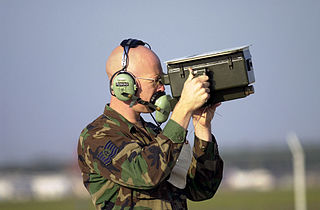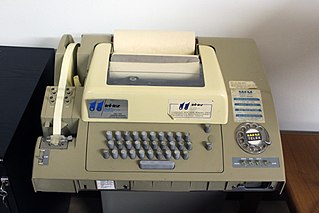
In telecommunication, a transponder is a device that, upon receiving a signal, emits a different signal in response. The term is a portmanteau for transmitter-responder. It is variously abbreviated as XPDR, XPNDR, TPDR or TP.
In telecommunications, a voice operated switch, also known as VOX or voice-operated exchange, is a switch that operates when sound over a certain threshold is detected. It is usually used to turn on a transmitter or recorder when someone speaks and turn it off when they stop speaking. It is used instead of a push-to-talk button on transmitters or to save storage space on recording devices. On cell phones, it is used to save battery life. Intercom systems that use a speaker in a room as both a speaker and a microphone will often use VOX on the main console to switch the audio direction during a conversation. The circuit usually includes a delay between the sound stopping and switching direction, to avoid the circuit turning off during short pauses in speech.
Radio-frequency identification (RFID) uses electromagnetic fields to automatically identify and track tags attached to objects. The tags contain electronically stored information. Passive tags collect energy from a nearby RFID reader's interrogating radio waves. Active tags have a local power source and may operate hundreds of meters from the RFID reader. Unlike a barcode, the tag need not be within the line of sight of the reader, so it may be embedded in the tracked object. RFID is one method of automatic identification and data capture (AIDC).

ISO/IEC 7810 Identification cards — Physical characteristics is an international standard that defines the physical characteristics for identification cards.
Radio Data System (RDS) is a communications protocol standard for embedding small amounts of digital information in conventional FM radio broadcasts. RDS standardizes several types of information transmitted, including time, station identification and program information.

Push-to-talk (PTT), also known as press-to-transmit, is a method of having conversations or talking on half-duplex communication lines, including two-way radio, using a momentary button to switch from voice reception mode to transmit mode.

Identification, friend or foe (IFF) is a radar-based identification system designed for command and control. It uses a transponder that listens for an interogation signal and then sends a response consisting of a unique signal that identifies the broadcaster. It enables military and civilian air traffic control interrogation systems to identify aircraft, vehicles or forces as friendly and to determine their bearing and range from the interrogator. IFF may be used by both military and civilian aircraft. IFF was first developed during the Second World War, with the arrival of radar, and several infamous friendly fire incidents.
Station identification is the practice of radio or television stations or networks identifying themselves on-air, typically by means of a call sign or brand name. This may be to satisfy requirements of licensing authorities, a form of branding or a combination of both. As such, it is closely related to production logos, used in television and cinema alike.

The Nokia 6230 is a mobile phone based on the Nokia Series 40 platform. It was announced on 28 October 2003 and released in February 2004.
Automatic identification and data capture (AIDC) refers to the methods of automatically identifying objects, collecting data about them, and entering them directly into computer systems, without human involvement. Technologies typically considered as part of AIDC include QR codes, bar codes, Radio Frequency Identification (RFID), biometrics, magnetic stripes, Optical character recognition (OCR), smart cards, and voice recognition. AIDC is also commonly referred to as “Automatic Identification”, “Auto-ID” and "Automatic Data Capture".
ISO 11784 & 11785 are international standards that regulate the radio frequency identification (RFID) of animals, which is usually accomplished by implanting, introducing or attaching a transponder containing a microchip to an animal.
A postal, telegraph, and telephone service is a government agency responsible for postal mail, telegraph, and telephone services. Such monopolies existed in many countries, though not in North America or Japan. Many PTTs have been partially or completely privatized in recent years. In some of those privatizations, the PTT was renamed completely, whereas in others, the name of the privatized corporation has been only slightly modified, such as PT Telkom in Indonesia.
Quindar tones, most often referred to as the "beeps" that were heard during the American Apollo space missions, were a means by which remote transmitters on Earth were turned on and off so that the Capsule communicator (CapCom) could communicate with the crews of the spacecraft. It was a means of in-band signaling to simulate the action of the push-to-talk and release-to-listen button commonly found on two-way radio systems and walkie-talkies.
Selcall is a type of squelch protocol used in radio communications systems, in which transmissions include a brief burst of sequential audio tones. Receivers that are set to respond to the transmitted tone sequence will open their squelch, while others will remain muted.
Real-time locating systems (RTLS) are used to automatically identify and track the location of objects or people in real time, usually within a building or other contained area. Wireless RTLS tags are attached to objects or worn by people, and in most RTLS, fixed reference points receive wireless signals from tags to determine their location. Examples of real-time locating systems include tracking automobiles through an assembly line, locating pallets of merchandise in a warehouse, or finding medical equipment in a hospital.

The telex network was a public switched network of teleprinters similar to a telephone network, for the purposes of sending text-based messages. Telex was a major method of sending written messages electronically between businesses in the post-World War II period. Its usage went into decline as the fax machine grew in popularity in the 1980s.
The Automatic Transmitter Identification System (ATIS) is a marine VHF radio system used and mandated on navigable inland waterways in Europe for identifying the ship or vessel that made a radio transmission. The identity of the vessel is sent digitally immediately after the ship's radio operator has finished talking and releases their transceiver's push-to-talk button. This contrasts to the Automatic identification system(AIS) used globally on ships that transmit continuously. A short post-transmission message is sent by the radio with the vessel identity and is in the form of an encoded call sign or Maritime Mobile Service Identity, starting with number "9" and the three country-specific maritime identification digits.

A ship identifier refers to one of several types of identifiers used for maritime vessels. An identifier may be a proper noun ; a proper noun combined with a standardized prefix based on the type of ship ; a serial code; a unique, alphanumeric ID ; or an alphanumeric ID displayed in international signal flags. Some identifiers are permanent for a ship while others may be changed at the owners' discretion although regulatory agencies will need to approve the change. Modern ships will usually have several identifiers.







